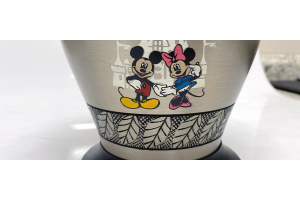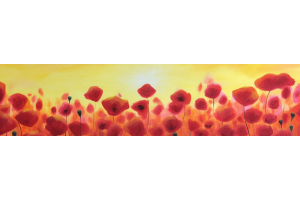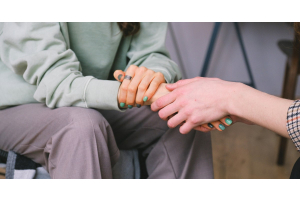
Building something worthwhile calls for many different skills, which often reside inside different people. Our customers have ideas that they want to turn into an entirely custom cremation urn, using the 3D printing capabilities of In The Light Urns. We are constantly refining our skills and services so that we know precisely how to recreate a thought or an image into a 3D model, and then create an urn to look just like it. Working with our lead designer, Krystal Cassano, the process relies on customer input and feedback all the time. In this way, our client acts like a chief visionary, helping to guide our skilled design team to generate the perfect cremation urn.
The Concept of 3D Printing
For people who are accustomed to manufacturing the old-fashioned way, 3D printing is really a revolutionary method of printing a custom item. When a regular printer prints a picture onto paper, it places layers of colored ink in a particular way according to the file that has been provided to the printer. The result is a full-color image that looks complete. The process of 3D printing is pretty similar. A 3D printer takes a 3D image and converts it into a real item. The printer puts thin layers of different kinds of material (e.g. calcium sulfate dehydrate, metal, wood, plastic) on top of each other in a design that meets specifications for size and proportion. The end product is exactly what the designer intended, a 3D image brought to life.
Building a Cremation Urn From the Ground Up
When we at In The Light Urns started incorporating 3D printing technology into our cremation urn creations, we were already in the business of offering the most custom urns available. Although we take pride in the many cremation urns we sell that feature traditional or classic styles, we have always aimed to push the envelope a little for our really inventive clients. The 3D printer took personalization to the next level. With a few years of experience under our belts now, we can take an idea–a mere vision of what someone remembers or has in mind to memorialize a loved one–and make it real. The process is complex and may take some time. But like a sculptor making an exquisite creation from a plain block of stone, the time is often worth it.
A Personal Process, Start to Finish
Michelangelo once said that he saw an angel in a piece of marble, and he carved until he set the angel free. Our customers come to us with an idea, and it is our job to take it from their imaginations and memories and set it free in the world. As a customer’s personal and unique plan, our 3D printed urns must be customer-driven at every stage of the process. This is part of the reason that creating a completely custom urn might take as long as 4-6 weeks. Although, we do try our best to tailor our processes to suit deadlines our clients are facing. We engage in a great deal of discussion back and forth, whether a customer is near our location in Visalia, CA, or thousands of miles away in the United Kingdom.
Gathering Design Details
In a lot of cases, our clients want us to build something that they do remember seeing in real life. Recently, we had the privilege of building a 3D printed urn of a Land Rover Defender, a beloved car of the brother of one of our customers. With Krystal Cassano as the lead on the project, we were able to provide a precise replica in a delightful and representative cremation urn. In a design that is as well-known as a particular make and model of car, perspective and proportion is key. We ask for as many photographs as possible, from different positions and lighting. This way, we get the most information available that we can use to render the 3D model.
Creating a 3D Model
Although every part of 3D printing calls for attentive care from an expert, the production of the 3D model is the most crucial. This step may take several days, as we usually like to communicate with a customer regularly to get input on various aspects of the overall design. The creation of the model from two-dimensional pictures is sometimes referred to as “3D rendering.” We make a 3D model out of software that ensures that the proportions turn out just right, at a size we specify. Until we are ready to show a design that is ready to print, we provide regular updates on our progress.
Reviewing and Revising the Design
Sometimes, the initial creation of a 3D model might not be entirely accurate, particularly if we only have one or two pictures of the item we have been tasked with building. This makes the last review and revision step so important, because it gives our customers another opportunity to weigh in on the design. They can comment on the color, shape, or size. If we need to tweak the design in any way, we will send over another screen capture of the 3D model for customer approval. Our goal is to produce an urn that releases a person’s vision into the world, and we want to be absolutely sure we have it just right.
Constructing the Urn
Anyone who has not seen a 3D printer in action might not be aware of the amazing technology of this kind of machine. A cursory Google search will reveal that 3D printing uses a powdered substance–be it gypsum, steel or polycarbonate–to create individual layers. It might seem impossible to get a spotless design with this process, but we do it literally every day. Intricate features are no problem for the machine, if our 3D modeling has the precise details. The end result is breathtakingly accurate, with the clean lines of a new car, or the soft curves of a baby’s face.
Painting and Customization
Once the printing of the urn is complete we shift to the final steps of personalization, sending the print off to our in-house painter, Jared Urias. When they place an order, our customers tell us if they would like their 3D printed urn to be in full-color, or remain the bright white of the gypsum we often use. Our designs reflect their preferences. According to specifications, we may mount the urn onto a base that is also 3D printed, or made from another process. Our detailing staff provide the finishing touches, such as custom engraving and color-fill, to leave a final loving message on the urn. Days or weeks of careful work reaches its pinnacle when our customers open a package and see that we have set free the idea they envisioned and we built. The use of 3D printing to make a custom urn might be the ideal marriage of machine and memory. When they lose a loved one, people want to hang onto their memories as long as they can, with tangible reminders that help them to keep those experiences fresh. Our 3D printing process allows us to take something as well-loved and remembered as a favorite car and create a miniature replica that will look spot-on and serve as a loving, final gift. Since our customers claim a place of great prominence throughout the design and construction of their custom urns, they can rest assured that the urn they buy will look like their ideas were always real, and simply set free by our service.





